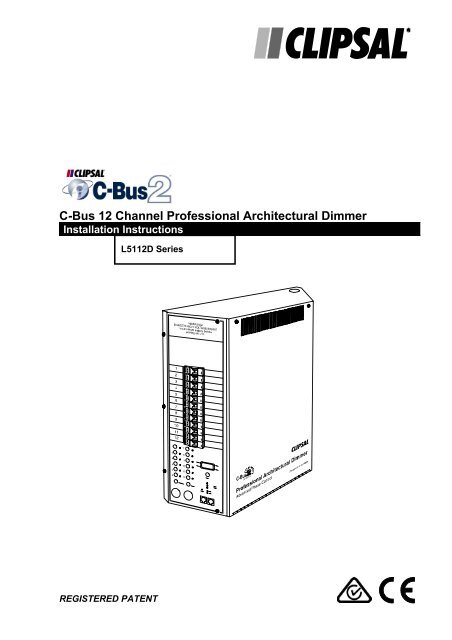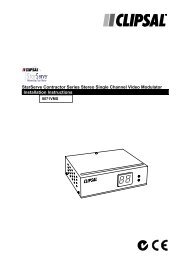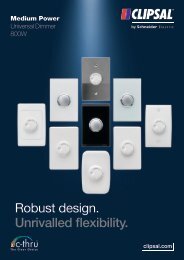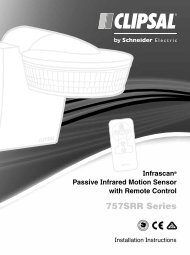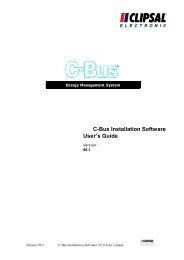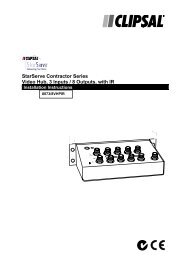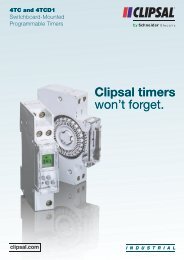Installation Instructions - Clipsal
Installation Instructions - Clipsal
Installation Instructions - Clipsal
You also want an ePaper? Increase the reach of your titles
YUMPU automatically turns print PDFs into web optimized ePapers that Google loves.
C-Bus 12 Channel Professional Architectural Dimmer<strong>Installation</strong> <strong>Instructions</strong>L5112D SeriesREGISTERED PATENT
Intelligent Building SeriesC-Bus 12 Channel Professional Architectural Dimmer <strong>Installation</strong> <strong>Instructions</strong>Table of ContentsSection......................................................................................................Page1.0 Product Range................................................................................ 42.0 General Description ........................................................................ 43.0 Features.......................................................................................... 54.0 Front Panel Layout ......................................................................... 64.1 Channel Output Circuit Breakers........................................................ 64.2 Display ............................................................................................... 64.3 Control, Flash and Set Push Buttons ................................................. 64.4 C-Bus Connection.............................................................................. 64.5 DMX In/Out Connectors ..................................................................... 64.6 LED Indicators ................................................................................... 64.7 PHASE Indicators .............................................................................. 64.8 C-Bus Indicators ................................................................................ 74.9 Channel Push Buttons ....................................................................... 74.10 Channel STATUS LEDs..................................................................... 75.0 Getting Started................................................................................ 85.1 Compatible Loads .............................................................................. 85.2 Connecting Power.............................................................................. 95.3 Connecting Loads ............................................................................ 105.4 Connecting C-Bus Input ................................................................... 125.5 Connecting C-Bus Remote Override Input....................................... 135.6 C-Bus Power Requirements............................................................. 135.7 Connecting DMX-512 Input.............................................................. 135.8 Preparing the Dimmer ...................................................................... 136.0 Dimmer Operation from the Front Panel....................................... 146.1 Power Up ......................................................................................... 146.2 Display ............................................................................................. 146.3 Viewing Channel Output Level......................................................... 146.4 Flashing a Channel .......................................................................... 146.5 Disable/Enable a Channel................................................................ 146.6 C-Bus Local Toggle.......................................................................... 156.7 C-Bus2 Learn Mode......................................................................... 156.8 C-Bus Remote Overrides ................................................................. 166.9 Viewing the Software Version Number............................................. 166.10 Fault Conditions and Reporting........................................................ 176.11 Fault Codes...................................................................................... 176.12 Advanced Features.......................................................................... 186.13 Minimum Output Channel Level....................................................... 196.14 Maximum Output Channel Level...................................................... 196.15 Viewing and Setting the Channel Curves......................................... 206.16 Channel Line Voltage....................................................................... 216.17 Viewing and Setting the Channel Patch ........................................... 217.0 Priority of Operating Modes .......................................................... 228.0 Fault Diagnosis ............................................................................. 238.1 Protection......................................................................................... 238.2 Output Faults ................................................................................... 248.3 DMX Faults ...................................................................................... 248.4 Phase Fault Indication...................................................................... 248.5 Error Messages................................................................................ 248.6 Fault Finding Guide.......................................................................... 259.0 Maintenance ................................................................................. 26© Copyright 2003 <strong>Clipsal</strong> Integrated Systems Pty Ltd. Page 2
Intelligent Building SeriesC-Bus 12 Channel Professional Architectural Dimmer <strong>Installation</strong> <strong>Instructions</strong>9.1 External Cleaning............................................................................. 269.2 Internal Cleaning.............................................................................. 269.3 Routine Maintenance ....................................................................... 2610.0 Power Surges and Short Circuit Conditions ................................. 2611.0 Megger Testing............................................................................. 2712.0 Important Notes ............................................................................ 2713.0 Standards Complied ..................................................................... 2814.0 Product Specifications .................................................................. 3015.0 Mechanical Specifications ............................................................ 3315.1 Dimensions ...................................................................................... 3315.2 Mounting Brackets ........................................................................... 34© Copyright 2003 <strong>Clipsal</strong> Integrated Systems Pty Ltd. Page 3
Intelligent Building SeriesC-Bus 12 Channel Professional Architectural Dimmer <strong>Installation</strong> <strong>Instructions</strong>1.0 Product RangeL5112D10B2L5112D12B2L5112D16B2L5112D10BN2L5112D12BN2L5112D16BN2L5112D10B2SL5112D10BN2S5150SMB5150DMB5150DMXC-Bus Professional Dimmer, 12 channel, 10A, 220-240Vac, MCCBprotection (1P), 200uSec rise time, 40-80Hz, with APC technology.C-Bus Professional Dimmer, 12 Channel, 12A, 220-240Vac, MCCBprotection (1P), 200uSec rise time, 40-80Hz, with APC technology.C-Bus Professional Dimmer, 12 Channel, 16A, 220- 240Vac, MCCBprotection (1P), 200uSec rise time, 40-80Hz, with APC technology.C-Bus Professional Dimmer, 12 Channel, 10A, 220-240Vac, MCCBprotection (DPN), 200uSec rise time, 40-80Hz, with APC technology.C-Bus Professional Dimmer, 12 Channel, 12A, 220-240Vac, MCCBprotection (DPN), 200uSec rise time, 40-80Hz, with APC technology.C-Bus Professional Dimmer, 12 Channel, 16A, 220-240Vac, MCCBprotection (DPN), 200uSec rise time, 40-80Hz, with APC technology.C-Bus Professional Dimmer, 12 Channel, 10A, 220-240Vac, MCCBprotection (1P), 200uSec rise time, 40-80Hz, with APC technology.With 12 x 10A GPO on front panel.C-Bus Professional Dimmer, 12 Channel, 10A, 220-240Vac, MCCBprotection (DPN), 200uSec rise time, 40-80Hz, with APC technology.With 12 x 10A GPO on front panel.Shallow Mounting BracketDeep Mounting BracketDMX Connector Kit2.0 General DescriptionThe C-Bus 12 Channel Professional Architectural Dimmers are rugged, high qualitydimmer packs that are specifically designed for architectural dimming applications.The “Advanced Phase Control” (APC) switching technique gives greater efficiencyresulting in cooler operation and ultimately improved reliability.The C-Bus 12 Channel Professional Architectural Dimmers feature microprocessorbaseddigital control. Front panel buttons, channel switches, LED indicators and sevensegmentdisplay enable the user to monitor and select the built-in functions.The user has the ability to select the DMX address, test selected channels while theremainder of the dimmer stays “on line”, select output voltage (e.g. 120V) or rampcurves for designated channels. Other functions provided include dimmer “soft” startand channel-by-channel preheat function.The C-Bus 12 Channel Professional Architectural Dimmers feature opto-controlledelectronics switching devices with carefully designed chokes. These chokes providehigh rise-time along with excellent high frequency noise suppression and low acousticnoise.The C-Bus 12 Channel Professional Architectural Dimmers have been designed toallow for future optional upgrades to the operating system.© Copyright 2003 <strong>Clipsal</strong> Integrated Systems Pty Ltd. Page 4
Intelligent Building SeriesC-Bus 12 Channel Professional Architectural Dimmer <strong>Installation</strong> <strong>Instructions</strong>Control to the Dimmer is from CBus (front or rear) and, under CBus switched controlfrom DMX, which may be connected to the internal DMX connector, or to the (optional)front panel connector.The dimmed outlets and the three-phase power entry are located on the rear panelinside the dimmer.3.0 Features• Excellent energy efficiency with patented APC technology• Intuitive operator interface including:• Direct access to frequently used functions• LED per channel of indication of level and status• DSP based design for unsurpassed power for a product in this class• Extensive software features including:• Voltage limiting• User-selectable dimming curves• Soft-patch of output channels to DMX• Configurable fade rates• 32 configurable C-Bus scenes• 1 Restore scene• Software-configurable from C-Bus• Soft Start• Rugged, light-weight steel construction• Cool, quiet and reliable operation• Dynamic, real-time Frequency Tracking provides the flexibility to operate from 40Hz to80Hz even on distorted supply including generators.• Output voltage line regulation• Can be fitted with RCD for safety protection• Generously rated thermal/magnetic circuit breakers• Optional DPN breaker models available• LED “phase available” indication• Control protocols:• C-Bus• DMX512• Remote over-ride control• C-Bus network voltage measurement available via C-Bus network• Built in selectable C-Bus network burden and network clock generator for simple networkinstallations• Status monitoring and remote reporting• Totally digital hard firing• 13 bit fade resolution© Copyright 2003 <strong>Clipsal</strong> Integrated Systems Pty Ltd. Page 5
Intelligent Building SeriesC-Bus 12 Channel Professional Architectural Dimmer <strong>Installation</strong> <strong>Instructions</strong>4.0 Front Panel Layout4.1 Channel Output Circuit BreakersEach output channel is fitted with a circuit breaker. These are rated to provideprotection to both the dimmer channel and the load wiring. While the dimmerwill comfortably supply current at the rating of the circuit breaker, werecommend the maximum load connected to a channel be limited to 10A for the10A versions, 12A for the 12A versions and 16A for the 16A versions.4.2 DisplayA red three-digit seven-segment display is used to show dimmer status and theoptions menus. This display can also be used for retrieving the current unitconfiguration and other parameters.4.3 Control, Flash and Set Push ButtonsThese switches are used to select different functions and operating modes aswell as for setup and testing.4.4 C-Bus ConnectionParallel RJ-45 connectors are provided on the front panel for connection toC-Bus. These connectors facilitate the connection of C-Bus power, data andremote overrides from the C-Bus system.4.5 DMX In/Out ConnectorsParallel male and female 5-pin AXR connectors can be fitted (5150DMX) for thecontrol desk DMX-512 signal. Internal connection for DMX is also provided.4.6 LED Indicators4.6.1 DMX LED (amber)• Off: Indicates no DMX• On: DMX is present• Flashing: DMX was present but is not any more4.6.2 RUN LED (green)• Flashing: Dimmer is operating correctly• Off or On: Dimmer has failed4.6.3 ADDRESS LED (red)• On: Indicates that the 7 segment display is showing a DMX address4.6.4 LEVEL LED (red)• Red LED indicates that a channel’s output level is currently displayed onthe three-digit seven-segment display4.7 PHASE IndicatorsThree green LEDs that, when lit, indicate that mains voltage has been detectedon the input to the dimmer electronics. Note that the dimmer must be turned onfor these indicators to work. Be aware that voltage could be present on inputterminals even if these LEDs are not lit.© Copyright 2003 <strong>Clipsal</strong> Integrated Systems Pty Ltd. Page 6
Intelligent Building SeriesC-Bus 12 Channel Professional Architectural Dimmer <strong>Installation</strong> <strong>Instructions</strong>4.8 C-Bus Indicators4.8.1 Unit IndicatorThis indicator shows the status of the C-Bus network at this unit. Ifsufficient network voltage and a valid C-Bus clock signal are present the“OK” signal will be displayed. If a network is connected which demandsmore current that the power supplies can support, this indicator will flashmeaning a marginal network voltage. If there is no C-Bus clock presentthe indicator will not light.Indicator StatusOnFlashingOffMeaningC-Bus network operationalInsufficient power to support networkNo C-Bus present4.8.2 C-Bus IndicatorThis indicator shows the channel mode. Continuous illumination indicatesthat the device is connected to a powered C-Bus network. If the indicatoris flashing with a 90% duty cycle, it means that one of the twelve channelshas been toggled (using the override facility) into a state different to the C-Bus network. This applies to either Local or Remote Override inputs. If theunit is not powered from mains but connected to a powered C-Busnetwork the indicator will still function.Indicator StatusOnFlashingOffMeaningNormal OperationUnit in override modeC-Bus not connected or C-Bus not powered4.9 Channel Push ButtonsThese buttons allow control and configuration for each of the output channels.The function of these are operating mode dependent and discussed later.4.10 Channel STATUS LEDsEach output channel has a tri-colour LED to indicate output channel status.Indicator StatusMeaningFlashing RedChannel Disabled by UserRedChannel Fault: IsolatedOff Channel Output is 0%AmberChannel Output is 1% or greater under C-Bus ControlGreenChannel Output is 1% or greater under DMX Control© Copyright 2003 <strong>Clipsal</strong> Integrated Systems Pty Ltd. Page 7
Intelligent Building SeriesC-Bus 12 Channel Professional Architectural Dimmer <strong>Installation</strong> <strong>Instructions</strong>5.0 Getting Started5.1 Compatible LoadsThe C-Bus 12 Channel Professional Architectural Dimmers are capable ofdimming several categories of lighting loads.• Resistive loads, eg. Incandescent and tungsten halogen lamps.• Inductive loads, eg. Iron core transformers for LV lighting, ceiling fans.• Electronic loads compatible with phase control, eg. Electronictransformers for LV lighting, some electronic ballasts for fluorescentlighting and discharge lamps.5.1.1 Inductive-Input Electronic Transformers – Full Load RatingElectronic transformers for LV lighting incorporating an input seriesinductor (eg. ATCO TEC series electronic transformer) are most suitablefor phase control dimming due to the inductive load presented to thedimmer unit.The full load rating of the 12 Channel Professional Architectural Dimmersapplies when using these types of electronic transformers and also ironcore transformers.5.1.2 Capacitive-Input Electronic Transformers – Limited Load RatingElectronic transformers for LV lighting without an inbuilt series inputinductor (eg. OSRAM HTM series electronic transformer) are lesspreferred for phase control dimming due to the capacitive loadingpresented to the dimmer unit.The maximum quantity of low-voltage lighting that can be controller withthese types of electronic transformers is determined by the capacitance ofthe transformers. The unit must not be loaded with more than 5nF forevery Watt of total channel load. The total load for these types oftransformers must not exceed 10A per channel.Note: Exceeding the loading limit for this type of electronic transformermay result in excessive EMI emissions or cause damage to the dimmerunit channel.Load TypeResistive andIncandescentInductive (e.g.Transformers, ACMotors)Capacitive (e.g.Electronic Low VoltageTransformers)Minimum loading150 Watts150 Watts150 Watts© Copyright 2003 <strong>Clipsal</strong> Integrated Systems Pty Ltd. Page 8
Intelligent Building SeriesC-Bus 12 Channel Professional Architectural Dimmer <strong>Installation</strong> <strong>Instructions</strong>5.2 Connecting PowerThe mains supply to the 12 Channel Professional Architectural Dimmers mustbe protected by upstream circuit breakers or fuses rated at 50 amps or less.The power terminal block is located in the upper right hand corner of the unit, asshown in the diagram below. This terminal block can accommodate powerwiring of 6.0mm 2 wire diameter. A threaded post connecting to the chassis isprovided for the earth wire termination.The power plug should be connected to an appropriately rated outlet socked.The plug’s retaining lock ring (if present) must be screwed home.Turn on the power and check that the three PHASE LED indicators are on. Ifthe PHASE indicators or the display indicate a fault condition, power down andremedy the fault before trying again. Do not attempt to wire in the loads beforechecking the mains connection.After the power-up sequence, the display will flash the software revisionnumber, and then return to the previously selected status display.If all is well, power down and proceed to the next section.UseCable TypeSupply Cables (A & N) 6.0 mm 2Load Cables (L & N) 4.0 mm 2 or 2.5mm 2© Copyright 2003 <strong>Clipsal</strong> Integrated Systems Pty Ltd. Page 9
Intelligent Building SeriesC-Bus 12 Channel Professional Architectural Dimmer <strong>Installation</strong> <strong>Instructions</strong>5.3 Connecting LoadsAn internally mounted terminal block is provided for the connection of wiring forthe loads. As shown in the above table the terminal block can accommodateload cable wiring of 4.0mm 2 wire diameter.Below is a diagram of the inside of the C-Bus 12 Channel ProfessionalArchitectural Dimmers. The Supply and Load terminal blocks are on the righthand side of the unit.© Copyright 2003 <strong>Clipsal</strong> Integrated Systems Pty Ltd. Page 10
Intelligent Building SeriesC-Bus 12 Channel Professional Architectural Dimmer <strong>Installation</strong> <strong>Instructions</strong>For each channel there is provided an Active, Neutral and Earth terminal. Thisterminal block can accommodate load wiring of 4.0mm 2 wire or 2 x 2.5mm 2wire.WARNING1. Do not wire dimmer channels in parallel.2. Load terminals are not isolated when the output is in the OFF state.3. A maximum of 80 C-Bus 12 Channel Professional Architectural Dimmerscan be connected to a single network.4. Do not short dimmer channel output to neutral or earth.© Copyright 2003 <strong>Clipsal</strong> Integrated Systems Pty Ltd. Page 11
Intelligent Building SeriesC-Bus 12 Channel Professional Architectural Dimmer <strong>Installation</strong> <strong>Instructions</strong>5.4 Connecting C-Bus InputThe installation of the C-Bus 12 Channel Professional Architectural Dimmersrequires connection to the unshielded twisted pair C-Bus Network Cable. It isrecommended that Category 5 data cable is used, <strong>Clipsal</strong> catalogue number5005C305B. The connection is polarity sensitive.The use of non-specified cable for C-Bus, or failing to ensure the correctconductor pairs are used to make the C-Bus connection, will void the warrantyof the system.C-Bus can be connected to the C-Bus 12 Channel Professional ArchitecturalDimmers in 2 places: The two front-mounted RJ-45 connectors or the internallymounted 4-way connectors.A maximum of 80 C-Bus 12 Channel Professional Architectural Dimmers can besafely connected to a single C-Bus network.The illustration below shows the recommended technique for cable terminationto give the best electrical performance.RJ Pin C-Bus Connection Colour1 Remote ON Green/White2 Remote ON Green3 C-Bus Neg (-) Orange/White4 C-Bus Pos (+) Blue5 C-Bus Neg (-) Blue/White6 C-Bus Pos (+) Orange7 Remote OFF Brown/White8 Remote OFF BrownNote:• It is recommended that the Remote Override (ON/OFF) connections bemaintained for correct operation of these services across the C-BusNetwork, even if they are not intended to be used. Remote Overrideservices may be disabled in software if necessary.• The mutual twist of solid and dotted conductors of opposing colouredconductors, which ensures a good electrical termination, with favorablecommon mode noise rejection characteristics.© Copyright 2003 <strong>Clipsal</strong> Integrated Systems Pty Ltd. Page 12
Intelligent Building SeriesC-Bus 12 Channel Professional Architectural Dimmer <strong>Installation</strong> <strong>Instructions</strong>5.5 Connecting C-Bus Remote Override InputRemote control of all channels on a unit canbe achieved via the extra pairs of conductorson the C-Bus connector or the internal 4-wayconnector. The diagram opposite showsswitches may be connected in parallel on anyone Network, using green and green/whiteconductors for the remote ON function. Brown+ brown/white may be wired in the samefashion for remote OFF, with theseconductors being connected to C-Busnegative via the switch to action this state. A<strong>Clipsal</strong> 30/1/2LM mechanism makes an idealremote input switch.NOTE:C-Bus is a balanced network and therefore atany point where C-Bus negative (-) is taken,C-Bus positive (+) must also be present.Hence both network conductors must belooped through all remote input switches onthe Network.5.6 C-Bus Power RequirementsThe C-Bus 12 Channel Professional Architectural Dimmers will draw 22mA fromthe C-Bus network. Adequate C-Bus power supply units must be installed tosupport the connected devices. If in doubt use the C-Bus calculator to verifynetwork design before proceeding.5.7 Connecting DMX-512 InputThe DMX input to the C-Bus 12 Channel Professional Architectural Dimmersconnects to the optional DMX in socket on the front panel or the internallymounted 4-way connector. The DMX signal may be daisy-chained to the nextdimmer or terminated by soldering a 120 ohm resistor across pins 2 and 3 of amale XLR plug and connecting to the female DMX out socket on the front panel.The DMX input signal should conform to the USITT DMX-512 (1990)specification. The amber DMX IN LED indicates the presence of DMX signals. IfDMX has been present, but is no longer preset, then the LED will flash.5.8 Preparing the DimmerConfiguration information for the C-Bus 12 Channel Professional ArchitecturalDimmers is stored in flash memory. This configuration can be reset to defaultvalues by pressing and holding both the CONTROL and FLASH buttons andeither cycling the power or pressing the reset button.This will configure the dimmer as follows:• All channels at LIN voltage• A 1:1 DMX patch based at 1• All channels set to dimming curve 3 (Lite 3)• All channels minimum and maximum to 0% and 100% respectively© Copyright 2003 <strong>Clipsal</strong> Integrated Systems Pty Ltd. Page 13
Intelligent Building SeriesC-Bus 12 Channel Professional Architectural Dimmer <strong>Installation</strong> <strong>Instructions</strong>6.0 Dimmer Operation from the Front PanelThis section assumes that the dimmer has been correctly connected to three-phasepower and sources of both C-Bus and DMX input signals.6.1 Power UpAt power up the green RUN LED is turned on. After a short delay the channelLEDs are cycled green, amber and red. The three phase LEDs are then cycled,the 7 segment LEDs are lit sequentially, the software version is shown, thecompile voltage is shown and then the DMX, RUN, ADDRESS and LEVELLEDs are lit together. Normal operation then starts.6.2 DisplayIn normal operation the display will say ‘buS.’. When the dimmer is connected toC-Bus the right most 7 segment decimal point will be lit.6.3 Viewing Channel Output LevelTo view the current output level for a channel whilst in DMX mode press andhold a channel button on the front control panel. To view the current output levelfor a channel whilst in C-Bus mode press and hold the SET button then press achannel button on the front control panel. This will show the output channellevel in percent on the 3-digit 7-segment display. While the level is being shownthe LEVEL LED on the front panel is lit.Note that this number is determined by the following parameters:• The current input level for that channel (either C-Bus or DMX)• The dimming curve applied to the channel• The minimum and maximum level scaling applied to the channel• The maximum voltage scaling applied to the channel• Whether or not the channel is disabled or isolated• Whether or not local overrides have been activated6.4 Flashing a ChannelPress and hold the FLASH button and press a channel button to flash achannel. If the channel output is at a level less than or equal to 80% the channelis flashed to 100%. If the channel output is greater than 80% the channel isflashed to 10%. While the channel is being flashed the level that it is beingflashed to is shown on the 7-segment display and the LEVEL LED on the frontpanel is lit.6.5 Disable/Enable a ChannelPress and hold the CONTROL button and press a channel button to disable orenable an output channel. Disabling a channel will set the output to 0%, and itwill no longer respond to C-Bus or DMX levels for that channel. A disabledchannel will have a red flashing LED associated with it. Enabling a disabledchannel will allow it to respond to C-Bus or DMX levels again. Note that achannel will remain disabled even if the dimmer is reset.© Copyright 2003 <strong>Clipsal</strong> Integrated Systems Pty Ltd. Page 14
Intelligent Building SeriesC-Bus 12 Channel Professional Architectural Dimmer <strong>Installation</strong> <strong>Instructions</strong>6.6 C-Bus Local ToggleThe buttons located on the front of the unit provide a means to toggle eachchannel locally. The associated LED indicator for each channel will beilluminated when the channel is in the ON state.Button OperationShort PressDouble Click(Two short presseswithin 2 seconds)Long Press(A press longer than 2seconds on any localoverride button)FunctionToggleReturns this channel only to the C-Bus network levelReturns ALL channels to C-Bus network levelNote:Double Click and Long Press operations will only occur if the unit/channel isalready in override mode.By default, C-Bus commands received by the unit will override local togglechanges. In this case only the channels associated with the receivedcommands will revert to the current C-Bus network state. This option may bedisabled via the <strong>Installation</strong> Software. Please refer to section 7.0 Priority ofOperating Modes.Local toggle buttons will not operate until a group address is assigned to achannel.6.7 C-Bus2 Learn ModeC-Bus2 Learn Mode is a quick and easy way of performing basic programmingof the C-Bus network. C-Bus2 Learn Mode allows the association of C-Businput units and output unit channels.6.7.1 Entering Learn ModeTo enter C-Bus2 Learn Mode hold down a toggle key on any output unitfor 10 seconds. The Unit and C-Bus indicators on all output units will flashalternately. All loads will turn off except for the one used to enter LearnMode that will turn on. All indicators on Input Units will turn off.6.7.2 Choosing the Electrical Loads to be controlledPress the toggle key switches on the Output Units that turn on the desiredloads. The unit and C-Bus indicators will continue to flash alternately andthe selected loads and indicators are switched on.© Copyright 2003 <strong>Clipsal</strong> Integrated Systems Pty Ltd. Page 15
Intelligent Building SeriesC-Bus 12 Channel Professional Architectural Dimmer <strong>Installation</strong> <strong>Instructions</strong>6.7.3 Selecting the Key Input SwitchesPress the Key Input button for a single key operated load. The button willthen function as a toggle dimmer.Alternatively, press two keys on the same Key Input unit for a two-keyoperated dimmer. The first key will be an on/up key and the second keypressed will be the off/down button.6.7.4 Exiting Learn ModeExit C-Bus2 Learn Mode by pressing and holding down any toggle switchon an output unit for 2 seconds. C-Bus2 will now learn the relationship andwill return to normal operation. The Unit and C-Bus indicators will stopflashing.6.8 C-Bus Remote OverridesTo activate the remote override a switch must be connected that, when closed,forms a connection between the Remote ON or Remote OFF wire to C-Buscommon (on the same connector).When remote ON is activated all channels are driven to 100%.When remote OFF is activated all channels are driven to 0%Note:Remote OFF is of higher priority than Remote ON.6.9 Viewing the Software Version NumberTo view the software version number press and hold the FLASH button & pressthe CONTROL button. The software version, in the form x.xx, is shown on the7-segment display.© Copyright 2003 <strong>Clipsal</strong> Integrated Systems Pty Ltd. Page 16
Intelligent Building SeriesC-Bus 12 Channel Professional Architectural Dimmer <strong>Installation</strong> <strong>Instructions</strong>6.10 Fault Conditions and ReportingThe C-Bus 12 Channel Professional Architectural Dimmers will report faultconditions using a 2 digit error code displayed on the 7-segment display. Faultsmay be detected at start up, or may be detected whilst the dimmer is running.The fault reporting mechanism is intended to be an advisory mechanism, andwill continue to indicate that a fault condition has occurred even after the faulthas been cleared, as you may not be present when the fault occurs.When a fault is being reported, the display will show a number in the format‘Exx’. The 7-segment display will alternate between showing the error code andshowing the current display setting. If more than one fault has been reported,the different error codes are displayed in sequence.The reported fault can be cleared when it is displayed by pressing and holdingthe CONTROL button and pressing the FLASH button.6.11 Fault Codes6.11.1 E01-E05These error codes are for manufacturer use only. If one of these errorcodes is displayed on the seven-segment display cease use of the unitand return to <strong>Clipsal</strong> Integrated Systems Pty Ltd6.11.2 E06 DMX Chip FailureIf the DMX communication chip does not respond as the C-Bus 12Channel Professional Architectural Dimmer starts up, Error 06 is reported.Try turning off the dimmer and turning it on again. If this does not clear thefault, contact <strong>Clipsal</strong> Integrated Systems Pty Ltd. Otherwise this fault willnot affect the performance of the dimmer.6.11.3 E07 Line Frequency Too LowThe C-Bus 12 Channel Professional Architectural Dimmer dynamicallymonitors the line frequency. If the line frequency drops below 40Hz theC-Bus 12 Channel Professional Architectural Dimmer will isolate all 12channels until the line frequency rises above 40Hz.6.11.4 E08 Line Frequency Too HighThe C-Bus 12 Channel Professional Architectural Dimmer dynamicallymonitors the line frequency. If the line frequency rises above 80Hz theC-Bus 12 Channel Professional Architectural Dimmer will isolate all 12channels until the line frequency drops below 80Hz.6.11.5 E09 Missing PhaseThe C-Bus 12 Channel Professional Architectural Dimmer dynamicallymonitors the presence of the three mains phases. If one or more of thephases is absent the C-Bus 12 Channel Professional ArchitecturalDimmer will indicate this with the E09 error message and the extinguishingof one or more of the neon phase indicators on the front panel. Loadsconnected to the missing phase or phases will not work. The loads on theremaining phase or phases will continue to operate.© Copyright 2003 <strong>Clipsal</strong> Integrated Systems Pty Ltd. Page 17
Intelligent Building SeriesC-Bus 12 Channel Professional Architectural Dimmer <strong>Installation</strong> <strong>Instructions</strong>6.12 Advanced FeaturesFeatures that do not need to be accessed regularly are located in the AdvancedFeatures Menu. To access the Advanced Features menu, press and hold theFLASH button, then hold the CONTROL button for 3 seconds. The softwareversion will be displayed for 3 seconds before displaying the first menu item. Toexit the Advanced Features menu, press and hold the FLASH button, then holdthe CONTROL button for 3 seconds.6.12.1 Menu StructureThe Advanced Features Menus are navigated with the CONTROL, FLASHand SET keys. Data entry is via the channel 1..10 keys to enter the digits1..9 and 0.At the topmost level press CONTROL to cycle forward through the menus,and FLASH to cycle backwards through the menus. To exit from theAdvanced Features menu press and hold both the CONTROL and FLASHbuttons for 3 seconds. This will work no matter what part of the AdvancedFeatures menu is being used. If a button is not pressed for 5 minutes thedimmer will revert to normal mode.As the menus are cycled through a three-character label will appear that isrelated to the feature as follows:LO: Set Minimum Output Level per channel (0..100%)HI: Set Maximum Output Level per channel (0..100%)CUR: Set Output Curve per channel (1 of 6 active curves)ACL: Set AC Output Limit per channel (50..110/220 volts)PAT: Set DMX Patch per channel (1..512)To enter a particular menu press the SET key.6.12.2 Copying Channel AttributesIt is possible to copy the settings of one channel to other channels when inthe Minimum Level, Maximum Level, Line Voltage, Patch, and Curvemenus.Whenever a channel setting is showing on the seven-segment display,and is not being edited (i.e. the display is not flashing) the holding downthe Flash key will show ‘CPY’ on the seven-segment display.Whilst ‘CPY’ is shown on the display pressing any of the channel keys(1..12) will copy the current channels attribute to the channel that has justbeen selected. Copying a channel to itself has no effect. The selectedchannels associated LED turns amber when the channel key is pressed incopy mode. As the channel key is pressed the value being copied isshown on the seven-segment display. You may copy an attribute as manytimes as you like. Releasing the FLASH key terminates Copy mode.© Copyright 2003 <strong>Clipsal</strong> Integrated Systems Pty Ltd. Page 18
Intelligent Building SeriesC-Bus 12 Channel Professional Architectural Dimmer <strong>Installation</strong> <strong>Instructions</strong>6.13 Minimum Output Channel LevelThe level that is output on the load may have a minimum level set. In this way aminimum brightness level for each channel can be assigned, such that the loadwill not dim below the selected minimum output channel level. This feature isvery useful for loads that are to remain on at a minimum setting, regardless ofthe control level. For situations where turning on large loads causes thebreakers to trip, due to large in-rush currents, a minimum brightness setting canbe used to pre-heat the filament to reduce the turn-on in-rush current.To view the minimum output channel level when LO shows in the display, pressthe SET button. All 12 channel LEDs will flash. Press a channel button to viewthe minimum output channel level for that channel. Press CONTROL to returnto the previous menu.To change a minimum output level, press the SET button whilst a minimumoutput channel level is being displayed. The century digit will flash. Press achannel button in the range 1..9 or 0, or press the SET button to leave thecurrent value. Repeat for the tens and units value. You may press theCONTROL button at any time while a digit is flashing to cancel the change.You may enter a number in the range 0..100.6.14 Maximum Output Channel LevelThe level that is output on the load may have a maximum level set. In this way amaximum brightness level for each channel can be assigned, such that the loadwill not dim above the selected maximum output channel level. This feature isvery useful for loads that are not required to be run at full brighness and formatching brightness intensities between different load types.To view the maximum output channel level when HI shows in the display, pressthe SET button. All 12 channel LEDs will flash. Press a channel button to viewthe maximum output channel level for that channel. Press CONTROL to returnto the previous menu.To change a maximum output level, press the SET button whilst a maximumoutput channel level is being displayed. The century digit will flash. Press achannel button in the range 1..9 or 0, or press the SET button to leave thecurrent value. Repeat for the tens and units value. You may press theCONTROL button at any time while a digit is flashing to cancel the change.You may enter a number in the range 0..100.© Copyright 2003 <strong>Clipsal</strong> Integrated Systems Pty Ltd. Page 19
Intelligent Building SeriesC-Bus 12 Channel Professional Architectural Dimmer <strong>Installation</strong> <strong>Instructions</strong>6.15 Viewing and Setting the Channel CurvesA fade curve determines how the dimmer output responds to changes indimmer input. Typically a fade curve is used to compensate for the non-linearresponse of the power modules. By default the Lite 3 curve (curve 3) is appliedto each dimmer channel. This curve has been developed over a period of timeto produce a fade that is pleasing to the eye for 1kW to 2kW loads.To view the channel curve when CUR shows in the display, press the SETbutton. All 12 channel LEDs will flash. Press a channel button to view the curvefor that channel. Press CONTROL to return to the previous menu.To change a channel curve, press the SET button whilst a channel curve isbeing displayed. The unit digit will flash. Press a channel button in the range1..8, or press the SET button to leave the current value. Repeat for the tens andunits value. You may press the CONTROL button at any time while a digit isflashing to cancel the change.You may enter a number in the range 1..8.Output key to press Curve name Shown on display1 Lite 1 L-12 Lite 2 L-23 Lite 3 L-34 Non Dim n-d5 Lin RMS Lin6 1-1 1-17 & 8 Further expansion C7, C8© Copyright 2003 <strong>Clipsal</strong> Integrated Systems Pty Ltd. Page 20
Intelligent Building SeriesC-Bus 12 Channel Professional Architectural Dimmer <strong>Installation</strong> <strong>Instructions</strong>6.16 Channel Line VoltageThe output of each channel may be limited in a range 50..220 Volts. Monitoringthe line voltage for each phase, and compensating for any changes in linevoltage achieve this control. This control is accurate to ± 10%. That is, an outputline voltage of 110V is selected then the dimmer may generate a voltage inrange 99 to 121 volts. If the channel output voltage is measured, then a TrueRMS type voltmeter must be used, as the AC waveform is chopped. Be awarethat this is an electronic control. Should a power device short circuit, the loadcould be subject to the actual line voltage and may suffer some damage. Inaddition, if the C-Bus 12 Channel Professional Architectural Dimmer is subjectto electrical noise it may falsely trigger the power devices. In this case the loadwill be subject to transient voltage for a short period of time, and will probablynot suffer damage.Note that if a channel line voltage is selected that is greater than the actual linevoltage, the maximum output of the channel can only be the local line voltage.To view a channel line voltage when ACL is displayed in the display press theSET button. All 12 channel LEDs will flash. Press a channel button to view thechannel voltage for that channel. Press CONTROL to return to the main menu.To change a channel voltages press the SET button whilst a channel voltage isbeing displayed. The century digit will flash. Press a channel button in the range1..9 or 0, or press the SET button to leave the current value. Repeat for the tensand units values. Press the CONTROL button at any time while a digit isflashing to cancel the change.You may enter a number in the range 50..220 volts. Entering a number higherthan 220 will set the output to track the line input, and show “LIN” on thedisplay. For normal usage each channel should be set to “LIN”.The output current will automatically adjust to fit the selected output voltage.6.17 Viewing and Setting the Channel PatchThe C-Bus 12 Channel Professional Architectural Dimmer can patch individualchannels to any DMX input channel available. That is, it determines which DMXinput channel is used to control a specified dimmer channel On the C-Bus 12Channel Professional Architectural Dimmer a dimmer channel may only beassociated with one DMX input channel.To view the channel patch when PAT shows in the display, press the SETbutton. All 12 channel LEDs will flash. Press a channel button to view the patchfor that channel. Press CONTROL to return to the previous menu.To change a channel patch, press the SET button whilst a channel patch isbeing displayed. The century digit will flash. Press a channel button in the range1..9 or 0, or press the SET button to leave the current value. Repeat for the tensand units value. You may press the CONTROL button at any time while a digitis flashing to cancel the change.You may enter a number in the range 1..512.© Copyright 2003 <strong>Clipsal</strong> Integrated Systems Pty Ltd. Page 21
Intelligent Building SeriesC-Bus 12 Channel Professional Architectural Dimmer <strong>Installation</strong> <strong>Instructions</strong>7.0 Priority of Operating ModesLoads connected to the C-Bus 12 Channel Professional Architectural Dimmer arecontrolled by a combination of C-Bus keys, Local Override buttons and/or RemoteSwitch functions. Loads are also turned off when the dimmer overheats or channels aredisabled. The table below shows the priority ranking of the control inputs:* Local Override has priority over normal C-Bus commands received on the bus (suchas those generated by pressing a C-Bus key). Y default, if any channel is in LocalOverride mode and a C-Bus command is received for that channel, the C-Buscommand state will be imposed (“Enable C-Bus Priority” option). This feature can bedisabled in software such that the unit whilst in Local Override Mode will ignore allrelevant C-Bus commands. Please refer to the C-Bus Manual for further informationrelating to the programming of PRO Series dimmer units.Mode Priority FunctionMax Voltage Scaling 1 (Highest) Maximum output voltageChannel Isolated 2 Fault conditionChannel Disabled 3 User disableChannel Curve Scaling 4User selectable dimmingcurvesMaximum Level Scaling 5 Max output levelMinimum Level Scaling 6 Min output levelFlash Channel 7 Flash output to maxRemote OFF 8 C-Bus override OFFRemote ON 9 C-Bus override ONLocal Toggle 10 * Buttons on front panelC-Bus 11 * (Lowest) C-Bus input levelNote:When channels of the C-Bus 12 Channel Professional Architectural dimmer are beingcontrolled by DMX rather than C-Bus the Remote OFF, Remote ON and C-Bus modesare not used. The DMX signal becomes the lowest priority input signal to the unit.© Copyright 2003 <strong>Clipsal</strong> Integrated Systems Pty Ltd. Page 22
Intelligent Building SeriesC-Bus 12 Channel Professional Architectural Dimmer <strong>Installation</strong> <strong>Instructions</strong>8.0 Fault Diagnosis8.1 ProtectionC-Bus 12 Channel Professional Architectural Dimmers feature several types ofprotection. These can generally be classified as:• Output protection• Thermal protection• Over voltage protection• Over and under frequency protection• Soft Start8.1.1 Output ProtectionEach of the twelve output circuits is protected by a fast-acting thermalmagnetic circuit breaker. These breakers are designed to pass the ratedcurrent, but will disconnect the output circuit for any overload condition(the larger the overload, the quicker the disconnection).The breakers protect the dimmers output devices from short-circuit loadsand faulty wiring looms, and save on expensive dimmer repairs. A trippedcircuit breaker indicates a load fault that requires immediate attention.8.1.2 Thermal ProtectionThe C-Bus 12 Channel Professional Architectural Dimmers featuretemperature-controlled fan cooling. As the internal temperature of thedimmer increases, the fan starts to operate. The fan operates attemperatures above 50 o C.8.1.3 Supply Power Fault ProtectionThe C-Bus 12 Channel Professional Architectural Dimmers electroniccircuits will tolerate significant over-voltages and accidentally transposedactive-neutral connection with no internal or output load damage.8.1.4 Over and Under Frequency ProtectionThe C-Bus 12 Channel Professional Architectural Dimmers constantlymonitor the mains frequency. If the mains frequency falls below 40Hz orabove 80Hz the unit will isolate all 12 output channels until the mainsfrequency returns to within range.8.1.5 Soft StartWhen a channel is first turned on to a level greater than 50% the voltageis limited for the first 5 mains half cycles (at 50Hz this is a duration of 0.05seconds). This allows the bulb filament to warm up, minimizing nuisancecircuit breaker tripping. Soft start is applied to a channel after it has beenat a level of 0% for a period greater than 1.5 seconds. This allows thechannel to be flashed on and off repeatedly, but have it soft start onlyonce.© Copyright 2003 <strong>Clipsal</strong> Integrated Systems Pty Ltd. Page 23
Intelligent Building SeriesC-Bus 12 Channel Professional Architectural Dimmer <strong>Installation</strong> <strong>Instructions</strong>8.2 Output FaultsIf a short-circuit lamp or output cable is plugged into the dimmer, the circuitbreaker will disconnect the fault from the dimmer. In nearly all circumstances, itis quick enough to prevent damage to the output devices in the dimmer. Insome instances however, a failure may be experienced, although the dimmer istypically robust to this. If an output channel is damaged isolate it with its circuitbreaker.8.3 DMX FaultsThe C-Bus 12 Channel Professional Architectural Dimmers feature a Last Holdfacility that remembers the last received DMX message. In the event of a DMXsignal cable being unplugged or severed, the dimmer will hold the last DMXsignal until a new DMX message is received. The DMX LED will light whenthere is a DMX signal, be off if the dimmer has not received DMX or flashcontinuously if a previously received DMX signal has disappeared.8.4 Phase Fault IndicationThe three green PHASE LEDs on the front panel will light when all three phaseshave power. A missing phase will also be reported as error “E09”.8.5 Error MessagesSeveral messages such as E06 though E09 may appear on the seven-segmentdisplay. These indicate error conditions. The RUN LED flashes rapidly to attractattention. Errors E07 to E09 will disable all the outputs. After properinvestigation, the messages can be erased from the display by holding theCONTROL key while pressing on the FLASH key. The table below provides themeaning of the messages:Display Description Clearing Fault IndicationE01-E05 Factory service -E06DMX PIC processor notrespondingPress CONTROL + FLASHE07 Line Frequency too low Press CONTROL + FLASHE08 Line Frequency too high Press CONTROL + FLASHE09 Missing Phase Press CONTROL + FLASHE10 (Reserved) -E11E99E98E97Missing or defectiveThermal ProbeBootstrap firmwarechecksum errorApplication firmwareChecksum errorConfigured ParametersdefaultedService callService callService callN/A© Copyright 2003 <strong>Clipsal</strong> Integrated Systems Pty Ltd. Page 24
Intelligent Building SeriesC-Bus 12 Channel Professional Architectural Dimmer <strong>Installation</strong> <strong>Instructions</strong>8.6 Fault Finding GuideFault Symptom Possible Cause RemedyOver voltage indicationLoose or missing supply neutral Ensure good neutral connectionOver-temperature indicationBreaker trips after prolongedoperationBreaker trips when channel isflashed to near fullBreaker trips immediately whenchannel is drivenOne channel flickers whendimmed – Drive LED flickersOne channel flickers whendimmed – associated LEDindicationAll channels flicker when dimmedby DMXFaulty supply connections orphase-neutral swap on supplyLoad imbalanceFaulty supply generatorLoose or missing earthPoor ventilationDamaged fan or fan thermoswitchAmbient temperature above limitExcessive load lamp or wiringfaultFaulty breakerExcessive loadFaulty breakerOutput shortDMX source problemFaulty channelSame load flickers on anotherchannelIncorrect DMX protocol wiringMains control tones exceed limitsCheck supply wiring/colour code.Re-distribute loadsReplace generatorEnsure correct supply earthCheck wiring/3 phase plugsEnsure unit has suitableventilationReplace fanKeep ambient temperature belowlimitReduce channel loadingCheck lamps and wiringFactory serviceReduce channel loadingFactory serviceCheck lamps and wiringFactory serviceCheck/replace DMX consoleand/or cablesFactory serviceInsufficient or non-linear loadIntermittent load wiringReplace DMX source/wiringFactory serviceDMX lines un-terminated Terminate DMX lineRadio interference Faulty choke or mains filter Factory service© Copyright 2003 <strong>Clipsal</strong> Integrated Systems Pty Ltd. Page 25
Intelligent Building SeriesC-Bus 12 Channel Professional Architectural Dimmer <strong>Installation</strong> <strong>Instructions</strong>9.0 Maintenance9.1 External CleaningIf the front panel requires cleaning, wipe with a mild detergent on a soft, dampcloth.UNDER NO CIRCUMSTANCES spray any kind of liquid onto the front panel.DO NOT use solvents for cleaning the front panel.9.2 Internal CleaningThe C-Bus 12 Channel Professional Architectural Dimmers will require littleinternal maintenance other than the periodic removal of dust build-up to preventthe fan and air-path becoming clogged with dirt and fluff.When cleaning the dimmer:• ISOLATE POWER to the dimmer (by disconnecting the power cable orlocking off the mains supply isolator).• Remove the front cover.• Blow clean the fan and internals with compressed air.• DO NOT spin the fan with compressed air. The fan blades may bebroken.• When the fan internals are clean, replace the lid and screws and reconnectthe power.• Make sure that the protective earth cable is connected to the lid beforeclosing the enclosure.9.3 Routine MaintenanceInstalled dimmers should be routinely flushed of dust at six to twelve-monthperiods. Touring dimmers may need a more rigorous maintenance routine,which should include:• Inspection of chassis for evidence of impact damage and physical abuse• Inspection of outlets for wear and damage• Inspection of power cables for wear and damage• Electrical checking of ground integrity from power cable to chassis• Electrical checking of ground integrity from power cable to outlet grounds• Flushing of dust build-up• Testing the operation of all front panel switches and breakers10.0 Power Surges and Short Circuit ConditionsAlthough the C-Bus 12 Channel Professional Architectural Dimmers have beendesigned to comply with the stringent requirements of Australian and Internationalstandards relating to power surges, the mains voltage supply must still be limited to therange specified. Each unit incorporates transient protection circuitry, however additionalexternal power surge protection devices can be used to enhance the system’simmunity.To prevent damage to the dimmers due to over voltage conditions, over voltageprotection devices such as the <strong>Clipsal</strong> 970 series, may be installed across each activesupply to the units.© Copyright 2003 <strong>Clipsal</strong> Integrated Systems Pty Ltd. Page 26
Intelligent Building SeriesC-Bus 12 Channel Professional Architectural Dimmer <strong>Installation</strong> <strong>Instructions</strong>11.0 Megger TestingMegger testing of an electrical installation incorporating C-Bus units will not causedamage to the C-Bus units. Since C-Bus units contain electronic components, theinstaller should interpret megger readings with due regard to the nature of the circuitunder test.<strong>Clipsal</strong> Integrated Systems recommends C-Bus 12 Channel Professional ArchitecturalDimmers are disconnected from the mains before megger testing.12.0 Important NotesThe use of any non C-Bus Software in conjunction with the hardware installation withoutthe written consent of <strong>Clipsal</strong> Integrated Systems will void any warranties applicable tothe hardware.© Copyright 2003 <strong>Clipsal</strong> Integrated Systems Pty Ltd. Page 27
Intelligent Building SeriesC-Bus 12 Channel Professional Architectural Dimmer <strong>Installation</strong> <strong>Instructions</strong>13.0 Standards CompliedStandardEN 55015:2000, A1:2001AS 4051:1998CISPR 15:2002EN 60439-1:1999EN 60950:1992, A1:1993, A2:1993,A3:1995, A4:1997, A11:1997AS 3439-1EN 55082-1:1997AS/NZS 3100:1997, A5AS/NZS 3108:1994, A672/23/EEC89/336/EECTitleLimits and methods of measurement of radiodisturbance characteristics of electrical lighting andsimilar equipmentSpecification for low-voltage switchgear and controlgear assembliesElectromagnetic Compatibility – Generic immunitystandard part 1: Residential, commercial and lightindustrialGeneral Requirements for Electrical EquipmentRequirements for Safety Extra Low VoltageEuropean Union Directive on Electrical SafetyEuropean Union Directive on ElectromagneticCompatibility© Copyright 2003 <strong>Clipsal</strong> Integrated Systems Pty Ltd. Page 28
Intelligent Building SeriesC-Bus 12 Channel Professional Architectural Dimmer <strong>Installation</strong> <strong>Instructions</strong>14.0 DMX-Friendly Cable SelectorMAKE PART NO PAIRS GAUGE STRANDINGBELDEN 3150A 1 22 AWG 7 X 30BELDEN 3106A 1 22 AWG 7 X 30BELDEN 3107A 2 22 AWG 7 X 30BELDEN 9829 2 24 AWG 7 X 32BELDEN 9829WH 2 24 AWG 7 X 30 Low CapBELDEN 9841 1 24 AWG 7 X 32BELDEN 9842 2 24 AWG 7 X 32BELDEN 9843 3 24 AWG 7 X 32BELDEN 9844 4 24 AWG 7 X 32BELDEN 7200A 1 24 AWG 41 X 40BELDEN 7201A 2 24 AWG 41 X 40BELDEN 8123 2 28 AWG 7 X 36BELDEN 9804 2 28 AWG 7 X 36PROPLEX PC222P 1 22 AWG 19 X 34PROPLEX PC224P 2 22 AWG 19 X 34DATAPLEX WDP222TBK 1 22 AWG 16 X .02mmDATAPLEX WDP222TBK 2 22 AWG 16 X .02mm15.0 DMX Pin outputsPin1 GN2 DMX -3 DMX +4 & 5 LOOP© Copyright 2003 <strong>Clipsal</strong> Integrated Systems Pty Ltd. Page 29
Intelligent Building Series C-Bus 12 Channel Professional Architectural Dimmer <strong>Installation</strong> <strong>Instructions</strong>16.0 Product SpecificationsCat No L5112D10B2 L5112D12B2 L5112D16B2 L5112D10BN2 L5112D12BN2 L5112D16BN2 L5112D10B2S L5112D10B2NSGeneral LimitsAC Supply Voltage 220 - 240V~AC Supply Frequency 40 – 80HzFrequency Drift 2Hz/sec for normal operation – if exceeded, all loads turn On for 1 /2 sec & unit reverts to normal mode.Frequency Step Change 1Hz for normal operation – if exceeded, all loads turn On for 1 /2 sec & unit reverts to normal mode.Channels 12Max. Load RMS Currentper Channel10A12A 16A 10A 12A 16A 10A 10ABreaker Type Active Only Active + Neutral Active Only Active + NeutralOperating AmbientTemperature0 – 40 o COperating Humidity 0 – 95% RHPeak Non-repetitive HalfCycle Surge Current300ARMS Surge (Nonrepetitive)I 2 t for Fusing(10mSec Period)450A 2 SecPeak Repetitive HalfCycle Current55AMax Load ShuntCapacitance5nF per Watt (approx)Max. Number of Units ona single C-Bus Network80Compatible LoadsSuitable for incandescent, low voltage lighting and ceiling sweep fans (contact manufacturer).Suitable for electronic transformers compatible with leading edge dimmers.Minimum Load 150 Watts/channel (Resistive load), 150 Watts/channel (Inductive or Capacitive load)© Copyright 2003 <strong>Clipsal</strong> Integrated Systems Pty Ltd. Page 30
Intelligent Building Series C-Bus 12 Channel Professional Architectural Dimmer <strong>Installation</strong> <strong>Instructions</strong>Cat No L5112D10B2 L5112D12B2 L5112D16B2 L5112D10BN2 L5112D12BN2 L5112D16BN2 L5112D10B2S L5112D10B2NSGeneral LevelsOff State PowerConsumption
Intelligent Building Series C-Bus 12 Channel Professional Architectural Dimmer <strong>Installation</strong> <strong>Instructions</strong>Cat No L5112D10B2 L5112D12B2 L5112D16B2 L5112D10BN2 L5112D12BN2 L5112D16BN2 L5112D10B2S L5112D10B2NSRemote InputsOpen-state Voltage(On/Off Input)5VMaximum cable length C-Bus – 1000m, Alternative wire on 4-way connector – 1mRemote Input to C-BusIsolation VoltageNot isolatedRemote Override Input 2 x RJ-45 connectors, 1 x 4-way removable terminal blockStatus IndicatorsC-Bus Status Clock Present No Clock PresentVoltage ≥ 20V DC On OffVoltage < 20V DC Flashing OffVoltage < 15V DC Off OffUnit Status C-Bus Power ConditionsOn Present Normal OperationFlashing Present At least one channel in local or remote override modeOff Fail C-Bus not availableLoad Indicators (1 – 12)Load indicator is On (Amber) when dimmer output is On at any C-Bus determined dimming levelLoad indicator is On (Green) when dimmer output is On at any DMX determined dimming levelMechanicalMains Supply Terminals Accommodates 1 x 6.0mm 2Load Terminals Accommodates 1 x 4.0mm 2 or 2 x 2.5mm 2Dimensions 533 x 486 x 163mmWeight 21kg© Copyright 2003 <strong>Clipsal</strong> Integrated Systems Pty Ltd. Page 32
Intelligent Building SeriesC-Bus 12 Channel Professional Architectural Dimmer <strong>Installation</strong> <strong>Instructions</strong>17.0 Mechanical Specifications17.1 Dimensions53348627216322272All dimensions are in millimetres.© Copyright 2003 <strong>Clipsal</strong> Integrated Systems Pty Ltd. Page 33
Intelligent Building SeriesC-Bus 12 Channel Professional Architectural Dimmer <strong>Installation</strong> <strong>Instructions</strong>17.2 Mounting Brackets421.7123.9429.0496.933.631.628.431.6119.5411.034.032.099.7391.2221.7Cable Entry PointsUnit Mounting Points224.5163.1486.2486.2532.6532.6Deep Mounting BracketShallow Mounting BracketAll dimensions are in millimetres.© Copyright 2003 <strong>Clipsal</strong> Integrated Systems Pty Ltd. Page 34
Intelligent Building SeriesC-Bus 12 Channel Professional Architectural Dimmer <strong>Installation</strong> <strong>Instructions</strong>2 YEAR WARRANTY1. The benefits conferred herein are in addition to, and in no way shall be deemedto derogate; either expressly or by implication, any or all other rights andremedies in respect to <strong>Clipsal</strong> Integrated Systems Product, which the consumerhas under the Commonwealth Trade Practices Act or any other similar State orTerritory Laws.2. The warrantor is <strong>Clipsal</strong> Integrated Systems Pty Ltd of 12 Park Terrace, Bowden,South Australia, 5007. Telephone (08) 8269 0560. With registered offices in allAustralian States.3. This <strong>Clipsal</strong> Integrated Systems Product is guaranteed against faultyworkmanship and materials for a period of two (2) years from the date ofinstallation.4. <strong>Clipsal</strong> Integrated Systems Pty Ltd reserves the right, at its discretion, to eitherrepair free of parts and labour charges, replace or offer refund in respect to anyarticle found to be faulty due to materials, parts or workmanship.5. This warranty is expressly subject to the <strong>Clipsal</strong> Integrated Systems Productbeing installed, wired, tested, operated and used in accordance with themanufacturer's instructions.6. All costs of a claim shall be met by <strong>Clipsal</strong> Integrated Systems Pty Ltd, howevershould the product that is the subject of the claim be found to be in good workingorder, all such costs shall be met by the claimant.7. When making a claim, the consumer shall forward the <strong>Clipsal</strong> Integrated SystemsProduct to the nearest office of <strong>Clipsal</strong> Integrated Systems Pty Ltd with adequateparticulars of the defect within 28 days of the fault occurring. The product shouldbe returned securely packed, complete with details of the date and place ofpurchase, description of load, and circumstances of malfunction.© Copyright 2003 <strong>Clipsal</strong> Integrated Systems Pty Ltd. Page 35
Further InformationFor further information about programming and configuring the C-Bus 12 ChannelProfessional Architectural Dimmers, please consult the documentation supplied• 12 Channel Professional Architectural <strong>Installation</strong> <strong>Instructions</strong>The printed booklet you are now reading contains detailed information for theinstaller regarding unit mounting, wiring and C-Bus Network requirments. C-Bus12 Channel Professional Architectural Dimmers advanced features are alsopresented• 12 Channel Professional Architectural Programming GuideThe C-Bus 12 Channel Professional Architectural Dimmers Programming Guidepresents a comprehensive guide to programming requirements and advancedcapabilities of C-Bus 12 Channel Professional Architectural Dimmers.• C-Bus Learn Mode Operations and Programming GuideThe C-Bus Learn Mode Operations and Programming Guide presents acomprehensive guide to C-Bus Learn Mode and gives full details of this mode.• C-Bus Installer Training CoursesContact your nearest <strong>Clipsal</strong> Integrated Systems Sales or Technical SupportOfficer and enquire about <strong>Clipsal</strong> C-Bus Installer Training and CertificationPrograms today !!• Technical Support and TroubleshootingFor further assistance in using the C-Bus 12 Channel ProfessionalArchitectural Dimmers, please consult your nearest <strong>Clipsal</strong> IntegratedSystems Sales Representative or Technical Support Officer.Technical Support Hotline 1 300 722 247(Cost 25¢ per call, Australia Only)Technical Support Emailtechsupport.cis@clipsal.com.auSales Support Emailsales.cis@clipsal.com.au<strong>Clipsal</strong> Integrated Systems Website clipsal.com/cisProducts of <strong>Clipsal</strong> Integrated Systems Pty LtdABN 15 089 444 931Head Office12 Park Terrace, BowdenSouth Australia 5007International Phone +61 8 8269 0560International Fax +61 8 8346 0845Internetclipsal.com/cisE-Mail cis@clipsal.com.au 10364471


